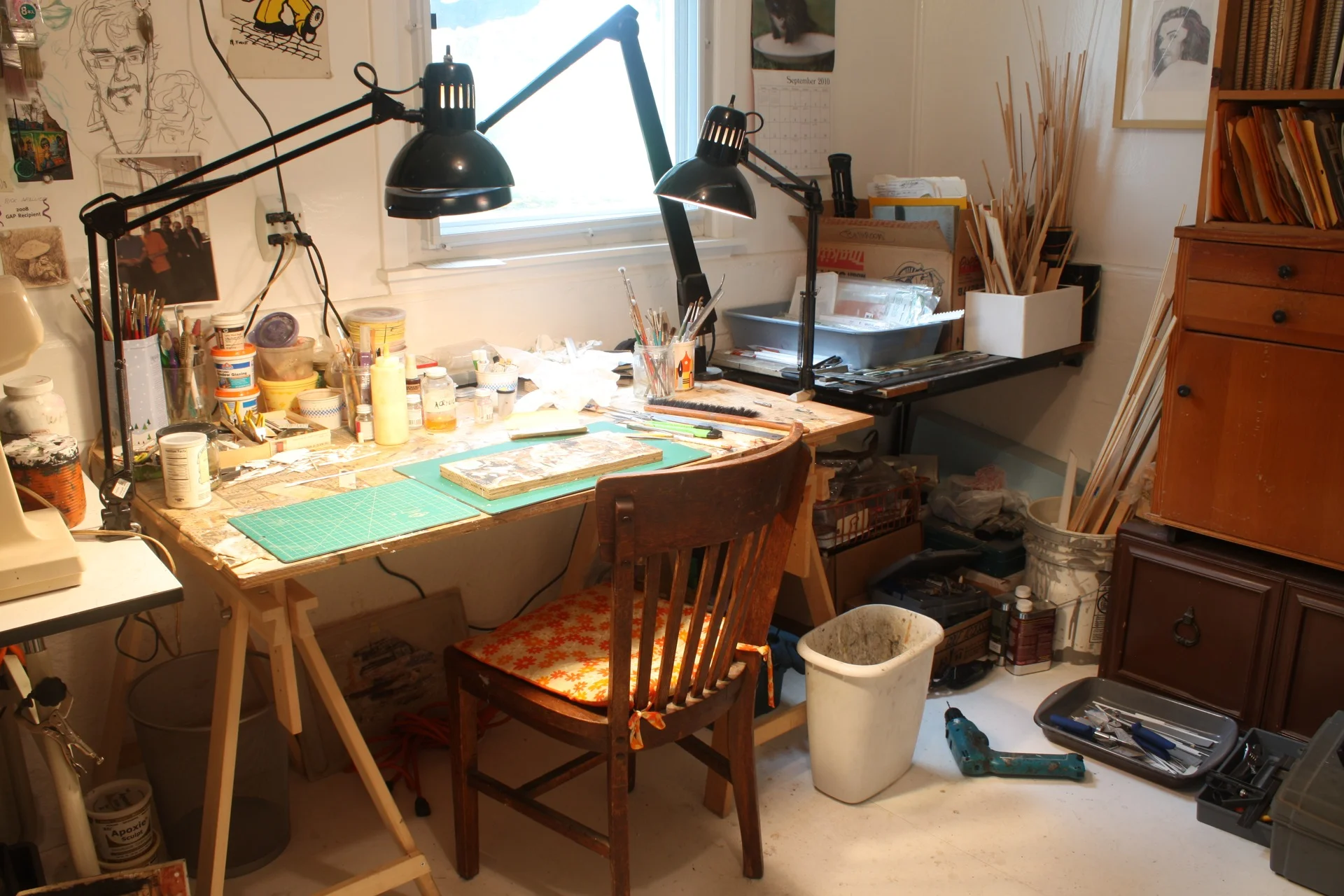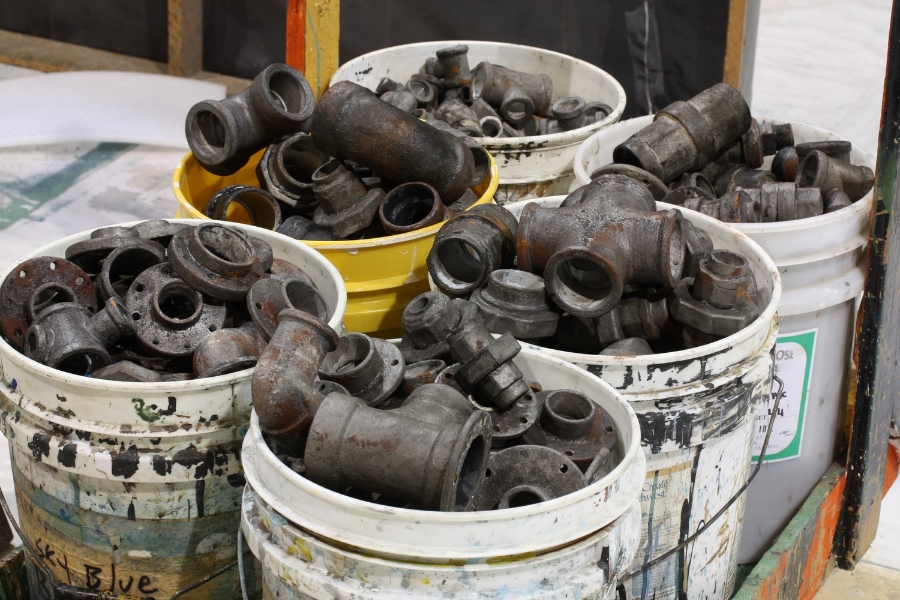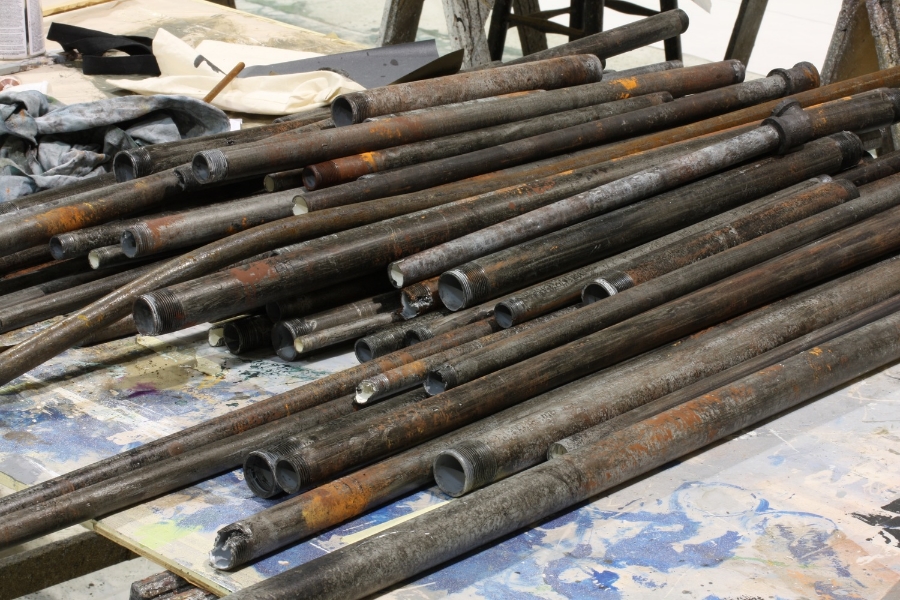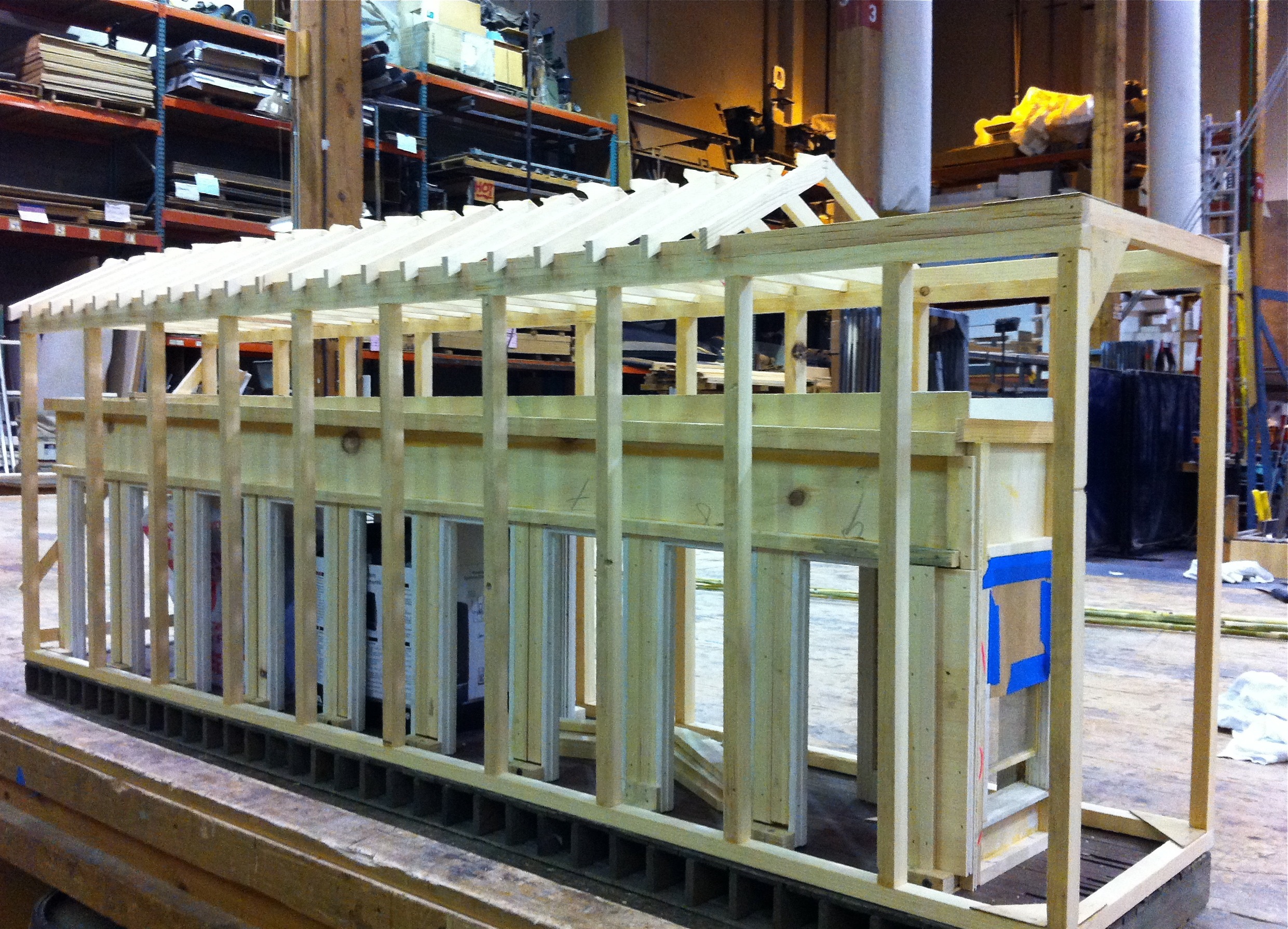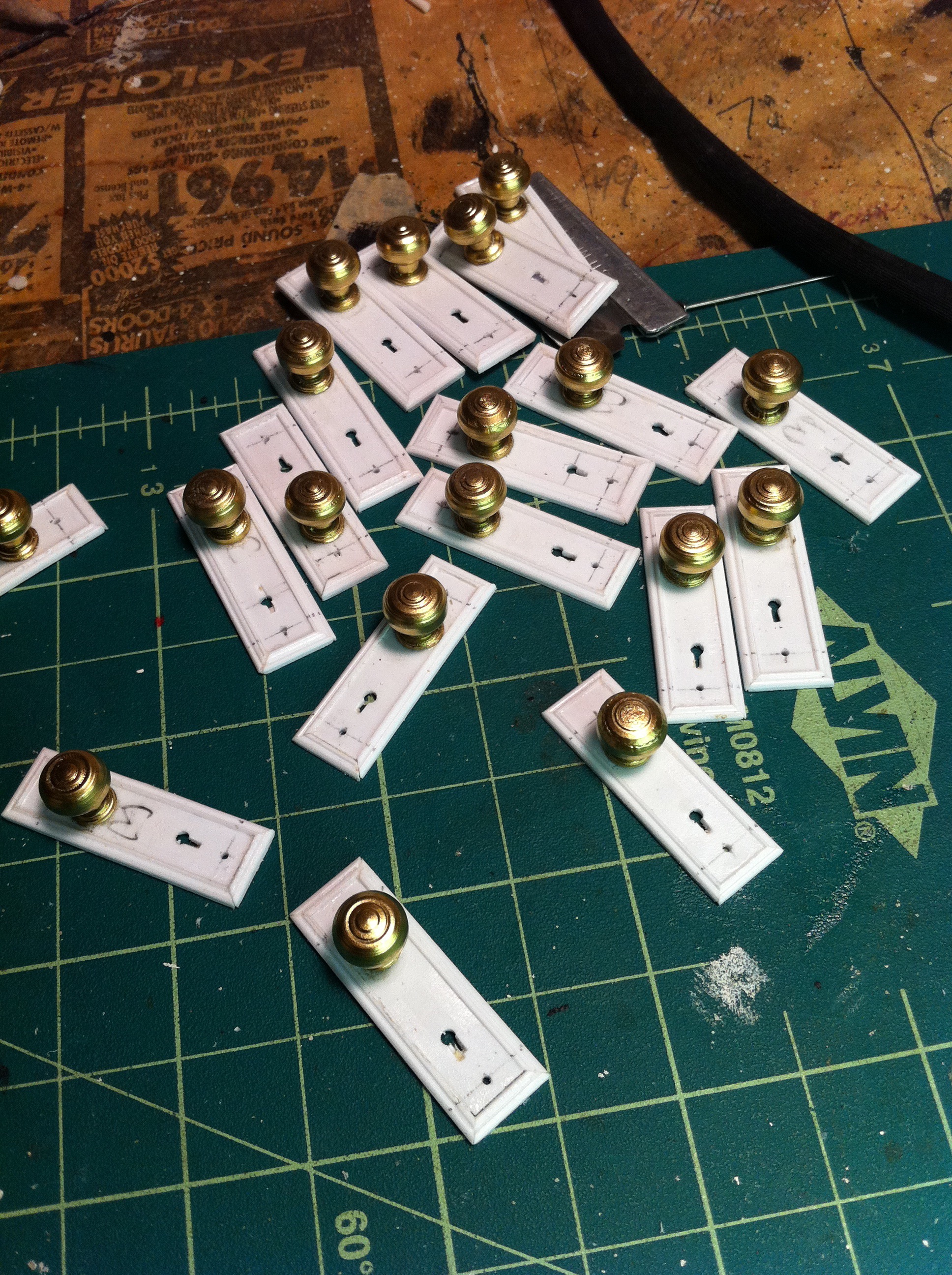Lille is a city in Northern France near Belgium that is a gigantic rail hub. It is quaint and beautiful. They have fantastic chocolate and fabulous beer. D'Artagnan of the Three Musketeers was Mayor back in the day, and Charles De Gaulle is a hometown hero. The city hosts a huge arts festival called Lille 3000 every year or so that takes over the entire city and surrounding towns. Museums and galleries hold special exhibitions, there are site-specific happenings and performances, installations and more. It's a big deal--especially in France. The final event is a giant parade through the center of town. In 2012 the city hosted Lille 3000 and the theme was Fantastic! As in: Lille 3000 Fantastique!
I was invited to create an artwork for an exhibition called Otherworldly: Optical Delusions and Small Realities at New York's Museum of Arts and Design (MAD) during the Summer of 2011. The show was wildly popular and successful with the critics, press, and the public. In fact, it was MAD's most popular exhibition ever, I was told. It was hoped that the exhibit would travel, but no other institutions stepped up until the Lille 3000 committee asked that the exhibit be reassembled and added to their festival lineup.
This was great news. I would have my artwork in a prestigious European arts festival! My first overseas museum exhibition! The venue was a mouthful to a non-French-speaker: MUba Eugéne Leroy Musée des Beaux arts de Tourcoing. Tourcoing is a town just outside Lille proper. Pronounced a bit like "tour-kwan" you get there by train, trolley, or bus. Europe rocks public transit.
But, back to the beginning.
First, there was a several month lag from when we participating artists got the good news from the Chief Curator at MAD, David McFadden, to when it was actually a go. It was long enough that some of us thought it wasn't going to happen. So, as is my want, I put off getting my passport. There's a little tale in that. Seems you need your birth certificate to get a US passport and I didn't have mine. I put off filing to get a copy of my birth certificate, which can take weeks and weeks to process and deliver. And it takes weeks and weeks to get a US passport. When I was finally notified that the exhibition was happening I had to scramble. Suffice to say, by the time I finally got my passport it was barely a week before we were to fly out. As the days ticked by I was sick with anxiety: to not be able to attend my first European exhibition because of a frigging technicality? Oh, did I mention you cannot buy a plane ticket without a passport, and you certainly cannot fly overseas without one. So I had to wait till the eleventh hour to buy tickets. And waiting till the last moment to buy tickets to France is, shall we say, a bit expensive. This is what procrastination does for you. It fucks your shit up.
Anyway, I got the tickets for me and my wife, Kitty, found a place to stay, arranged everything from my end. We even got translation apps for our iPhones. We we ready for our Lille adventure.
Everyone knows flying from the West Coast to Europe is a long-ass haul. Seattle to New York: 5 1/2 hours. New York to Paris: 8 hours. Paris to Lille: 2 1/2 hours. That doesn't include wait times between connections. By the time we got to our destination we were wiped, as you might imagine. The place I'd rented was through a private realtor who owned several condos in the city. His agent spoke very little English, and I spoke next to no French. We communicated initially through emails and Google-translate. With that setup I was praying that everything was going to be okay when we arrived.
It wasn't exactly okay.
We found the address, very near the huge Gare de Lille Flandres, the railway station we had arrived at on the high-speed TGV train from Paris. There was supposed to be someone there to greet us, give us the keys, show us the place.
There was no one there. We were on time--maybe a few minutes late--and I had been text messaging our progress all along. So, there should have been someone waiting. I began to get nervous. I called the number and got garbled reception and rapid fire French. Then the connection disappeared. I walked up and down the street, hoping for better signal. I called again and again. No dice. I began to get more nervous. At last I got someone on the phone who spoke a bit of English. He told us they'd be over in about 15--20. A half hour later I called again.10 more minutes I was told. I was wondering if we would be waiting all day, have to search about for a place to stay in a strange town where a giant city-wide festival had most likely soaked up all the available rooms and where almost no one spoke our language. This wasn't Paris, where seemingly everyone grudgingly spoke a little English, even if they rolled their eyes while doing so. After an hour or so a young couple showed up in a car to let us in. They needed a deposit, so I walked up the street past some hobos to the French ATM with directions all in French and pulled out a few hundred euros. I walked back to our pad, gave over the money and received the spiel.
I felt a huge wave of relief. We had our place! And it was kind of awesome; perched above a falafel restaurant on a lively street, three flights up a narrow staircase, clean, a nice little kitchen, bath and shower. We had almost a whole week before the exhibition, so we explored Lille by day, bought groceries and made our suppers in the apartment by night. I found out at the grocery store it is rude to take change from the cashier's hand, and that I needed to let them place the money on the counter before picking it up and putting it in my pocket. Fortunately, though I spoke next to no French, I discovered I was unafraid of trying communicate, however lame I must have sounded. I'm a little proud of that. How many people spend weeks and weeks taking lessons in a foreign language before a trip and then freeze when the moment arrives to speak? A whole bunch, I know. Anyway, I learned that a cheery "bon jour!" can go a long way to melting the ice with the locals. People appreciate when you make an effort.
Since I hadn't heard anything from the museum folks during this time, I assumed everything was fine with the install of my artwork. And so I didn't plan on stopping by the museum until the opening. No news was good news, I assumed.
I assumed wrong.
My wife and I were taking in the delightfully hoary old-fashioned Musée d’Histoire Naturelle in town when I got a call from Thea, who had come from MAD Museum in New York and was overseeing the install and acting as liaison with the visiting artists and the all-French-speaking staff at the museum. Thea spoke fluent French. But it wasn't French she was speaking when she called me on my phone while I sat on a marble bench as the museum was closing down for the day. It was plain English.
"Hey, Rick," she said, "wasn't there sound in your artwork?"
I felt a panicky flutter.
I should explain about The Longest Hours, my artwork in the exhibit. It is a totally engrossing piece of interdisciplinary sculpture I created from scratch. It took me months to create. It's five and a half feet long. It's an interior environment, a miniature nighttime hallway housed inside an architectural shell. Of course it's featured on this website. A tiny thunder and lightning storm flashes and rumbles beyond the window at the end of the hallway. It is sophisticated. In fact it's the most sophisticated artwork I had ever attempted. I created it specifically for Otherworldly, the show at MAD. There is lighting, there is audio, and a little micro processor called an Arduino automates the hall lights to flicker randomly from time to time and the LED "lightning" effect to flash outside in the darkness. Old big band radio music comes from an open door; thunder rumbles; dogs bark in the distance.
So, yes, there was "sound."
I ran through scenarios in my mind: the work had been shipped from Seattle, WA all the way to Lille in a big crate. Had something happened along the way? Could the Arduino had been fried somehow by some X-ray cargo scanner? Could the Arduino itself just have gone tits up? Devices do fail. Could the SD data card in the "audio shield" have been fried somehow? Could the audio shield itself have failed? Could one of the many little wires come loose somewhere inside the work? Could the install crew have forgotten to install a voltage converter to the plug and fried the artwork's electronics? Could could could. It seemed it could have been anything, really.
"Are you sure there's no sound?" I asked Thea. "It's kind of quiet at times."
"I don't think so."
Fuck.
Oh, here's the other thing: this was the day before opening night, so there was nothing I could do until tomorrow. My face felt clammy and my lips were numb. "Okay. I'll just have to come over tomorrow morning and see what I can do, I guess."
And here's the other thing: I hadn't wired up the intricate system. I did not know the hardware. Before this project I had never even heard of a gizmoid called an "Arduino." No, my brilliant arty-tech-nerd pal, Scott, had worked with me on it. And he was back in Seattle. I didn't even know what hour of the day it was back there. Middle of the wee hours? I felt well and truly fucked. My artwork wasn't working and I had no clue what to do to fix it and I was thousands of miles away in a country where I could barely communicate five words on the night before my opening. I texted my pal in Seattle. I called and left frantic messages. I felt sick. Maybe it's just a loose wire, simple to fix, I thought bleakly. Yeah, sure, I thought, miserable.
That night Kitty and I walked around historic Lille under a cold wet drizzle. Amazingly, I wasn't in a complete meltdown depression. Near the town square, the Grand Place, we saw what I knew to be one of the signature artworks for the festival. In fact it was the artwork that was the used as the official image of Lille 3000 Fantastic! on all the literature and posters and advertisements. It was a giant yellow shaggy inflatable character with red hair by the artist Nick Cave, a larger-than-life takeoff on his intricate "sound suits." Google "Nick Cave Lille 3000" if you want to know more. He's famous in the art world, has exhibited around the globe. I had met him extremely briefly the year before in New York during Fashion Week at an opening of his at Mary Boone gallery. He seemed like a cool cat.
The giant puppet was wet and sagging. Kind of sad-looking. It was being worked on by a crew using a boom lift. I explained to Kitty what we were seeing. "He's probably here somewhere," she said. "I know I would be, during install." She had a point. Since I'd met him before, I knew what he looked like.
"Well, he might be easy to spot since he's black and about 5-5."
We saw a small group standing by the work in rain suits. Maybe... We walked up and saw what surely had to be the artist. "How's it going?" I asked, meaning the installation.
"Problems. Seems he's a bit too wide to fit between the arcade." He meant a part of the parade route through town, motioning to the partially inflated puppet.
We chatted for a short while, then I told him I was having problems of my own. He looked at me, mirth and seriousness on his face "Well, you got to fix it! You got to make it so it works and it never fails again! Don't you?"
"That's what I'm going to try to do, man" I told him, thinking how unlikely that would be.
Kitty and I talked a bit more with Nick and his partner before I forced a thin smile on my face and parted ways.
Later on Scott called me from Seattle. We talked about the many things that might be wrong with the piece, tossed around ideas where the work could at least limp through the opening night celebration. None of it had me feeling horribly optimistic. Just talking about the myriad options and scenarios was exhausting and depressing. I thought I might cry, but I was too tired.
I think I had terrible futile dreams that night.
The next morning Kitty and I made our way to the museum. We were met by Thea, and Dorothée, Chief Curator of MUba, and her Assistant Curator, Yannick. Inside I saw some friends from the exhibit at MAD in New York. Some of them were having technical difficulties themselves. Maybe it was in the air.
I went over to my work, sitting on its pedestal. Sure enough: no sound. I removed the rear panel. I create my works to be accessible, just in case, you know, they need to be taken apart and worked on. Inside, the powered speaker wasn't working. It's little LED indicator was dark. Had it simply died? Been damaged during transport? I peeked and could see a tiny light blinking away on the Arduino, so at least it seemed to be functioning. I considered taking the work apart. I had created it to be able to do so. I thought unsteadily, what if I make it worse? Then there will be no lighting AND no sound! There were several hours until the opening that night. Kitty and Yannick thought I should at least take the work apart and have a look. Thea and I were nervous I might make it worse.
What to do?
Kitty and Yannick won out.
I asked for a screw gun. Thea translated. With the help of my fellow exhibiting artist pal, Alan Wolfson. the two of us carefully lifted the outer shell from the work to expose its innards. There were many many black and yellow wires running to and fro from the Arduino to the lighting, and cords running to a power strip mounted inside the work. A lot of wires and connections. A rat's nest of wires and connections. I looked around but didn't quite know what to do or how to proceed. I was off balance, I was grasping. I'm sure you can imagine.
All of us stood looking at the disassembled work, like a circle of dudes looking under the hood of a car without much of a clue.
Thea spoke up. "What's this?" She pointed to a black lumpy thing, a voltage converter, laying beside the power strip. It was lettered with paint pen in my awkward hand "SPKR."
It was unplugged. I stared for a moment, not comprehending. Ugh, what...?
Was that it? Had the powered speaker merely come unplugged during some bumpy segment of the transit? Had some ham-handed clumsy move by some careless shipper somewhere along the line knocked it loose? Whatever. I couldn't believe it might be that simple. I plugged the thing into the power strip and prayed a little prayer.
We put the work back together, plugged the thing in, flipped the switch and--
Voila! Sound!
I uttered a huge "YES!" startling the people around me, including Holly, MAD's Director who was here from New York for the exhibit, and who had just come in the door. I almost passed out from relief and joy. "YES!"
A bit later the several other artists, Thea, Holly, and ourselves were treated to a wonderful meal hosted by Dorothée and Yannick at a favored restaurant that afternoon. We had the upper floor to ourselves. It was charming and fabulous. My smile was wider that usual. I was content and happy and most of all relieved.








